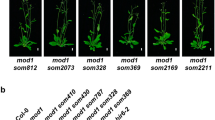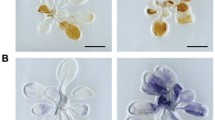Abstract
Reactive oxygen species (ROS) play a crucial role in numerous biological processes in plants, including development, responses to environmental stimuli, and programmed cell death (PCD). Deficiency in MOSAIC DEATH 1 (MOD1), a plastid-localized enoyl-ACP reductase essential for de novo fatty acid biosynthesis in Arabidopsis thaliana, leads to the increased malate export from chloroplasts to mitochondria, and the subsequent accumulation of mitochondria-generated ROS and PCD. In this study, we report the identification and characterization of a mod1 suppressor, som592. SOM592 encodes mitochondrion-localized NAD+ transporter 2 (NDT2). We show that the mitochondrial NAD pool is elevated in the mod1 mutant. The som592 mutation fully suppressed mitochondrial NADH hyper-accumulation, ROS production, and PCD in the mod1 mutant, indicating a causal relationship between mitochondrial NAD accumulation and ROS/PCD phenotypes. We also show that in wild-type plants, the mitochondrial NAD+ uptake is involved in the regulation of ROS production in response to continuous photoperiod. Elevation of the alternative respiration pathway can suppress ROS accumulation and PCD in mod1, but leads to growth restriction. These findings uncover a regulatory mechanism for mitochondrial ROS production via NADH homeostasis in Arabidopsis thaliana that is likely important for growth regulation in response to altered photoperiod.
Similar content being viewed by others
References
Ameisen, J.C. (2002). On the origin, evolution, and nature of programmed cell death: a timeline of four billion years. Cell Death Differ 9, 367–393.
Apel, K., and Hirt, H. (2004). Reactive oxygen species: metabolism, oxidative stress, and signal transduction. Annu Rev Plant Biol 55, 373–399.
Beers, E.P. (1997). Programmed cell death during plant growth and development. Cell Death Differ 4, 649–661.
Bleecker, A.B., and Patterson, S.E. (1997). Last exit: senescence, abscission, and meristem arrest in Arabidopsis. Plant Cell 9, 1169–1179.
Bruggeman, Q., Raynaud, C., Benhamed, M., and Delarue, M. (2015). To die or not to die? Lessons from lesion mimic mutants. Front Plant Sci 6, 24.
Clifton, R., Millar, A.H., and Whelan, J. (2006). Alternative oxidases in Arabidopsis: A comparative analysis of differential expression in the gene family provides new insights into function of non-phosphorylating bypasses. Biochim Biophys Acta-Bioenerg 1757, 730–741.
Clough, S.J., and Bent, A.F. (1998). Floral dip: a simplified method for Agrobacterium-mediated transformation of Arabidopsis thaliana. Plant J 16, 735–743.
Coll, N.S., Epple, P., and Dangl, J.L. (2011). Programmed cell death in the plant immune system. Cell Death Differ 18, 1247–1256.
Colombatti, F., Gonzalez, D.H., and Welchen, E. (2014). Plant mitochondria under pathogen attack: A sigh of relief or a last breath? Mitochondrion 19, 238–244.
Cvetkovska, M., and Vanlerberghe, G.C. (2012). Alternative oxidase modulates leaf mitochondrial concentrations of superoxide and nitric oxide. New Phytol 195, 32–39.
Dahal, K., and Vanlerberghe, G.C. (2018). Growth at elevated CO2 requires acclimation of the respiratory chain to support photosynthesis. Plant Physiol 178, 82–100.
Dauphinee, A.N., Fletcher, J.I., Denbigh, G.L., Lacroix, C.R., and Gunawardena, A.H.L.A.N. (2017). Remodelling of lace plant leaves: antioxidants and ROS are key regulators of programmed cell death. Planta 246, 133–147.
Dietrich, R.A., Delaney, T.P., Uknes, S.J., Ward, E.R., Ryals, J.A., and Dangl, J.L. (1994). Arabidopsis mutants simulating disease resistance response. Cell 77, 565–577.
Ding, P., Guo, H., and Jones, J.D.G. (2018). Deadlier than the malate. Cell Res 28, 609–610.
Fukuda, H. (1997). Tracheary element differentiation. Plant Cell 9, 1147–1156.
Gibon, Y., Blaesing, O.E., Hannemann, J., Carillo, P., Höhne, M., Hendriks, J.H.M., Palacios, N., Cross, J., Selbig, J., and Stitt, M. (2004). A robot-based platform to measure multiple enzyme activities in Arabidopsis using a set of cycling assays: comparison of changes of enzyme activities and transcript levels during diurnal cycles and in prolonged darkness. Plant Cell 16, 3304–3325.
Gray, J., Close, P.S., Briggs, S.P., and Johal, G.S. (1997). A novel suppressor of cell death in plants encoded by the Lls1 gene of maize. Cell 89, 25–31.
Hajirezaei, M.R., Peisker, M., Tschiersch, H., Palatnik, J.F., Valle, E.M., Carrillo, N., and Sonnewald, U. (2002). Small changes in the activity of chloroplastic NADP+-dependent ferredoxin oxidoreductase lead to impaired plant growth and restrict photosynthetic activity of transgenic tobacco plants. Plant J 29, 281–293.
Hao, J., Pétriacq, P., de Bont, L., Hodges, M., and Gakière, B. (2018). Characterization of l-aspartate oxidase from Arabidopsis thaliana. Plant Sci 271, 133–142.
Ho, L.H.M., Giraud, E., Uggalla, V., Lister, R., Clifton, R., Glen, A., Thirkettle-Watts, D., Van Aken, O., and Whelan, J. (2008). Identification of regulatory pathways controlling gene expression of stress-responsive mitochondrial proteins in Arabidopsis. Plant Physiol 147, 1858–1873.
Huang, S., Van Aken, O., Schwarzländer, M., Belt, K., and Millar, A.H. (2016). The roles of mitochondrial reactive oxygen species in cellular signaling and stress response in plants. Plant Physiol 171, 1551–1559.
Jabs, T. (1999). Reactive oxygen intermediates as mediators of programmed cell death in plants and animals. Biochem Pharmacol 57, 231–245.
Katoh, A., Uenohara, K., Akita, M., and Hashimoto, T. (2006). Early steps in the biosynthesis of NAD in Arabidopsis start with aspartate and occur in the plastid. Plant Physiol 141, 851–857.
Kim, K.S., Min, J.Y., and Dickman, M.B. (2008). Oxalic acid is an elicitor of plant programmed cell death during Sclerotinia sclerotiorum disease development. Mol Plant Microbe Interact 21, 605–612.
Lam, E. (2004). Controlled cell death, plant survival and development. Nat Rev Mol Cell Biol 5, 305–315.
Liang, C., Zhang, Y., Cheng, S., Osorio, S., Sun, Y., Fernie, A.R., Cheung, C.Y.M., and Lim, B.L. (2015). Impacts of high ATP supply from chloroplasts and mitochondria on the leaf metabolism of Arabidopsis thaliana. Front Plant Sci 6, 922.
Lyu, W., Selinski, J., Li, L., Day, D.A., Murcha, M.W., Whelan, J., and Wang, Y. (2018)Isolation and respiratory measurements of mitochondria from Arabidopsis thaliana. J Vis Exp.
Møller, I.M., and Sweetlove, L.J. (2010). ROS signalling—specificity is required. Trends Plant Sci 15, 370–374.
Maxwell, D.P., Wang, Y., and McIntosh, L. (1999). The alternative oxidase lowers mitochondrial reactive oxygen production in plant cells. Proc Natl Acad Sci USA 96, 8271–8276.
Meyer, E.H., Tomaz, T., Carroll, A.J., Estavillo, G., Delannoy, E., Tanz, S. K., Small, I.D., Pogson, B.J., and Millar, A.H. (2009). Remodeled respiration in ndufs4 with low phosphorylation efficiency suppresses Arabidopsis germination and growth and alters control of metabolism at night. Plant Physiol 151, 603–619.
Mhamdi, A., and Van Breusegem, F. (2018). Reactive oxygen species in plant development. Development 145, dev164376.
Mignolet-Spruyt, L., Xu, E., Idänheimo, N., Hoeberichts, F.A., Mühlenbock, P., Brosché, M., Van Breusegem, F., and Kangasjärvi, J. (2016). Spreading the news: subcellular and organellar reactive oxygen species production and signalling. J Exp Bot 67, 3831–3844.
Mou, Z., He, Y., Dai, Y., Liu, X., and Li, J. (2000). Deficiency in fatty acid synthase leads to premature cell death and dramatic alterations in plant morphology. Plant Cell 12, 405–418.
Palmieri, F., Rieder, B., Ventrella, A., Blanco, E., Do, P.T., Nunes-Nesi, A., Trauth, A.U., Fiermonte, G., Tjaden, J., Agrimi, G., et al. (2009). Molecular identification and functional characterization of Arabidopsis thaliana mitochondrial and chloroplastic NAD+ carrier proteins. J Biol Chem 284, 31249–31259.
Petrov, V., Hille, J., Mueller-Roeber, B., and Gechev, T.S. (2015). ROS-mediated abiotic stress-induced programmed cell death in plants. Front Plant Sci 6, 69.
Pineau, B., Layoune, O., Danon, A., and De Paepe, R. (2008). L-Galactono-1,4-lactone dehydrogenase is required for the accumulation of plant respiratory complex I. J Biol Chem 283, 32500–32505.
Reid, R.J.D., Sunjevaric, I., Keddache, M., Rothstein, R., and Kedacche, M. (2002). Efficient PCR-based gene disruption in Saccharomyces strains using intergenic primers. Yeast 19, 319–328.
Rhoads, D.M., and Vanlerberghe, G.C. (2004). Mitochondria-nucleus interactions: evidence for mitochondrial retrograde communication in plant cells. In Plant Mitochondria: From Genome to Function. D.A. Day, A.H. Millar, and J. Whelan, eds. (Dordrecht: Springer Netherlands), pp. 83–106.
Selinski, J., Scheibe, R., Day, D.A., and Whelan, J. (2018). Alternative oxidase is positive for plant performance. Trends Plant Sci 23, 588–597.
Tiwari, B.S., Belenghi, B., and Levine, A. (2002). Oxidative stress increased respiration and generation of reactive oxygen species, resulting in ATP depletion, opening of mitochondrial permeability transition, and programmed cell death. Plant Physiol 128, 1271–1281.
Van Aken, O., and Van Breusegem, F. (2015). Licensed to kill: mitochondria, chloroplasts, and cell death. Trends Plant Sci 20, 754–766.
Vanlerberghe, G.C. (2013). Alternative oxidase: A mitochondrial respiratory pathway to maintain metabolic and signaling homeostasis during abiotic and biotic stress in plants. Int J Mol Sci 14, 6805–6847.
Vanlerberghe, G.C., and McLntosh, L. (1996). Signals regulating the expression of the nuclear gene encoding alternative oxidase of plant mitochondria. Plant Physiol 111, 589–595.
Vishwakarma, A., Kumari, A., Mur, L.A.J., and Gupta, K.J. (2018). A discrete role for alternative oxidase under hypoxia to increase nitric oxide and drive energy production. Free Rad Biol Med 122, 40–51.
Wang, J., Zhou, L., Shi, H., Chern, M., Yu, H., Yi, H., He, M., Yin, J., Zhu, X., Li, Y., et al. (2018). A single transcription factor promotes both yield and immunity in rice. Science 361, 1026–1028.
Wang, L., Wang, B., Jiang, L., Liu, X., Li, X., Lu, Z., Meng, X., Wang, Y., Smith, S.M., and Li, J. (2015). Strigolactone signaling in Arabidopsis regulates shoot development by targeting D53-Like SMXL repressor proteins for ubiquitination and degradation. Plant Cell 27, 3128–3142.
Wu, J., Sun, Y., Zhao, Y., Zhang, J., Luo, L., Li, M., Wang, J., Yu, H., Liu, G., Yang, L., et al. (2015). Deficient plastidic fatty acid synthesis triggers cell death by modulating mitochondrial reactive oxygen species. Cell Res 25, 621–633.
Xu, Y.Z., Arrieta-Montiel, M.P., Virdi, K.S., de Paula, W.B.M., Widhalm, J. R., Basset, G.J., Davila, J.I., Elthon, T.E., Elowsky, C.G., Sato, S.J., et al. (2011). MutS HOMOLOG1 is a nucleoid protein that alters mitochondrial and plastid properties and plant response to high light. Plant Cell 23, 3428–3441.
Yoshinaga, K., Arimura, S.I., Niwa, Y., Tsutsumi, N., Uchimiya, H., and Kawai-yamada, M. (2005). Mitochondrial behaviour in the early stages of ROS stress leading to cell death in Arabidopsis thaliana. Ann Bot 96, 337–342.
Zhao, Y., Luo, L., Xu, J., Xin, P., Guo, H., Wu, J., Bai, L., Wang, G., Chu, J., Zuo, J., et al. (2018). Malate transported from chloroplast to mitochondrion triggers production of ROS and PCD in Arabidopsis thaliana. Cell Res 28, 448–461.
Acknowledgements
We thank Prof. Yu Fu and Dr. Huijun Xue (Institute of Microbiology, Chinese Academy of Sciences) for kindly providing the yeast cell strain BY4741 and assistance in yeast double mutant construction, and Nottingham Arabidopsis Stock Centre (NASC) for providing N648685 (som592-2), N450741 (ndt1-1), N423124 (ndt1-2). This work was supported by the National Natural Science Foundation of China (31521001, 91854103, 31661143025).
Author information
Authors and Affiliations
Corresponding authors
Rights and permissions
About this article
Cite this article
Luo, L., He, Y., Zhao, Y. et al. Regulation of mitochondrial NAD pool via NAD+ transporter 2 is essential for matrix NADH homeostasis and ROS production in Arabidopsis. Sci. China Life Sci. 62, 991–1002 (2019). https://doi.org/10.1007/s11427-019-9563-y
Received:
Accepted:
Published:
Issue Date:
DOI: https://doi.org/10.1007/s11427-019-9563-y




